We use cookies to make your experience better. To comply with the new e-Privacy directive, we need to ask for your consent to set the cookies. Learn more.
Directory of Chinese tea names
Directory of Chinese tea names
- Mao Feng (hairy peak / tip)
- Mao Jian (hairy tip)
- Yun Wu (Cloud nebula)
Directory of Chinese green tea names |
|
An Hua Song Zhen (pine needle of An Hua) Anhua County in Hu'nan Province, The mountains in Anhua County were still known growing regions until the end of the 19th century for green tea. The production methods were unfortunately lost. "To Hua Song Zhen" is a new creation in 1959. For the best quality level we only the bud and the first leaf just opened are used. |
|
An Ji Bai Pian (White Tea from Anji) Anji district in Zhejiang province, Created in 1981, for a more detailed description see tea varieties |
|
Bi Luo Chun (Pi Lo Chun, jade green spring snail) City of Suzhou in Jiangsu province, Description see Top 10 list |
|
Chen Zhou Bi Yun (Jade Green Cloud of Chen Zhou) Chen District in Hunan Province Chenzhou was the former name of the region, a well-known growing region since The tea plants are grown in mountainous areas between 1000 and 1400 meters above sea level. cultivated. |
|
Cui Luo (Jade green snail) Jiangning District in Jiangsu Province A new creation from 1984. In spite of the fully mechanised production "Cui Luo" by the fine plucking (a bud with 1 to 2 just opened leaves) a high quality green tea. |
|
Da Xian Feng Hao Cha (Hairy tea from Da Xian summit)
Datian district in Fujian province
The tea is named after the Daxian summit in the region. |
|
Ding Feng Hao (Hairy Summit Tea) City of Fuzhou in the province Fujian A new creation from 1990. |
|
Ding Gu Da Fang / Lao Zhu Da Fang (Da Fang tea from Ding Gu) Laozhu Mountain, Shexian District in Anhui Province Named after the monk named Da Fang, who created this tea about 400 years ago has. High quality "Da Fang"tea is also known as "Ding Gu Da Fang" is also called "Ding Gu Da Fang tea is produced in the neighbouring regions in Zhejiang Province cultivated. |
|
Dong Bai Chun Ya / Tai Bai Ding Ya (Spring sprout of Dong Bai
/ summit shoots) Dongyang district in Zhejiang province Named after the Dongbai mountain in the region and its highest peak - Tai Bai. The Dong Bai tea was already very famous in the 8th century. The tea plants are cultivated at an altitude between 800 and 900 metres. The tea has a high content of amino acids. |
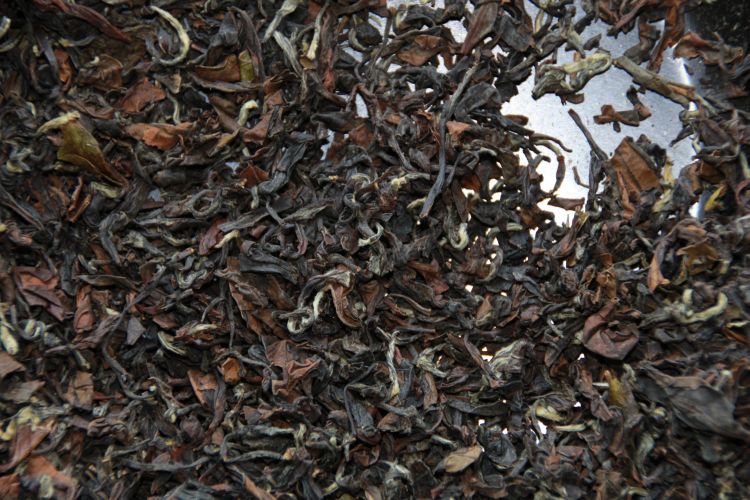 Dong Fang Mei Ren (oriental beauty)
Dong Fang Mei Ren (oriental beauty)
Fujian Province Originally from Taiwan, this highly fermented oolong is also grown in Fujian province. Not to be confused with the tea creation. |
|
Dong Hu Yin Hao (silver hair from Lake Dong Hu) City of Changsha in Hunan province The tea is grown around the Donghu Lake, after which it is also called. |
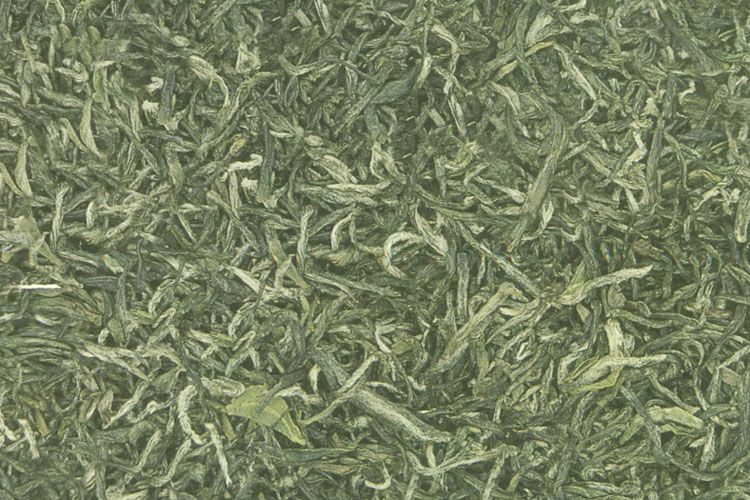 E Mei Mao Feng (Mao Feng of E Mei Mountain)
E Mei Mao Feng (Mao Feng of E Mei Mountain)
Emei mountain in Sichuan province The tea was created in 1978. |
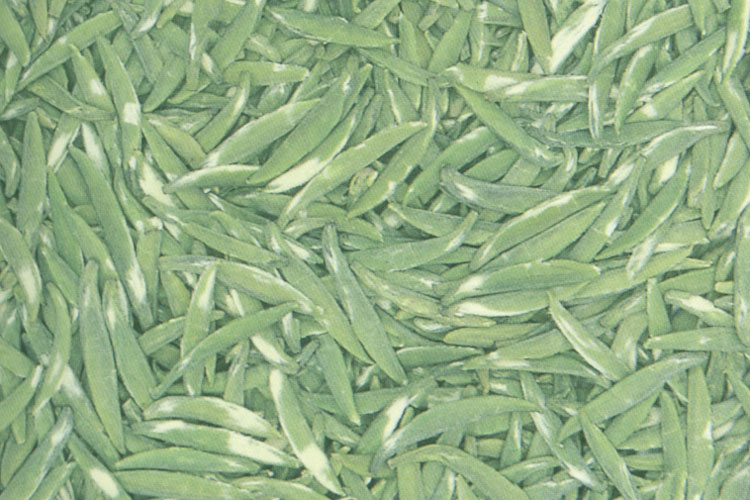 E Mei Zhu Ye Qing (round bamboo leaf from E Mei Mountain)
E Mei Zhu Ye Qing (round bamboo leaf from E Mei Mountain)
The flat shape and green colour of the tea is reminiscent of bamboo leaves and is also therefore called so. The tea plants grow at an altitude between 800 and 1200 meters. Picking takes place at the beginning of April. |
|
En Shi Yu Lu (Jade dew from En Shi) Enshi district in Hubei province One of China's rare steamed green teas. "Yu Lu" means in Chinese Jade Dew. The Japanese Gyokuro is written in Japanese in the same way like the Chinese "Yu Lu" - another remnant of the Chinese Tea culture in Japan. |
|
Fu Ning Yuan Xiao Lü (Yuan Xiao green from Fu Ning) Puxia district in Fujian province Funing was the historical city name of Puxia. The tea was created in 1991. "yuan Xiao" is an important folk festival on the day of the first full moon in China calendar year, i.e. 2 weeks after the Spring Festival (New Year's Festival) - the most important Festival in China. The tea is so called because the plucking is already at the "yuan Xiao"festival, usually in February. |
|
Fu Yun Qu Hao (crooked hairy tea from the tea plant Fu
Yun") Fu'an district in Fujian province A new creation. The tea is made from the tea plant "Fuyun No.7", a tea plant which has been refined by selective breeding. |
| Gou Gu Nao (dog-head tea) Suichuan district in Jiangxi province The tea is named after the "dog head" mountain (Gou Gu Nao Shan) in the region. The peculiar name of the mountain is due to the shape of the peak, which is reminiscent of a dog's head. |
|
Gu Shan Bai Yun (White Cloud of Gu Shan) City of Fuzhou in Fujian province Named after the Gu mountain near the city. |
|
Gu Zhang Mao Jian (Mao Jian vo Gu Zhang) Guzhang District in Hunan Province |
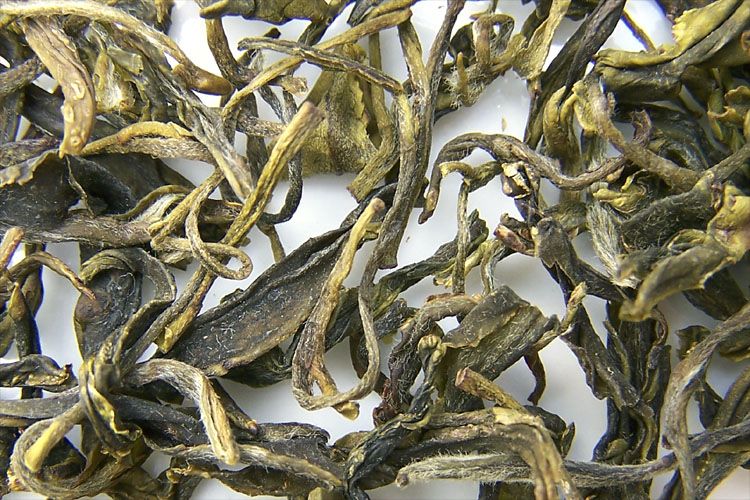 Gu Zhu Zi Sun (Purple sprout of Guzhu)
Gu Zhu Zi Sun (Purple sprout of Guzhu)
Changxing district in Zhejiang province A very famous teen name in the Tang Dynasty. Mentioned by Lu Yu in his book Disappeared from 16th - 17th century, revived in the 70s. |
|
Hua Ding Yun Wu (Cloud Fog Tea from Hua Ding) Tiantai district in Zhejiang province Named after the summit Hua Ding of the Tiantai mountain |
| Hua Guo Shan Yun Wu Cha (Cloud Fog Tea from Hua Guo Mountain) Lianyungang District in Jiangsu Province The Huaguo mountain in the region has a long growing tradition. |
|
Hui Ming Cha (Hui Ming tea) Jingning district in Zhejiang province Named after the Buddhist monastery Hui Ming. |
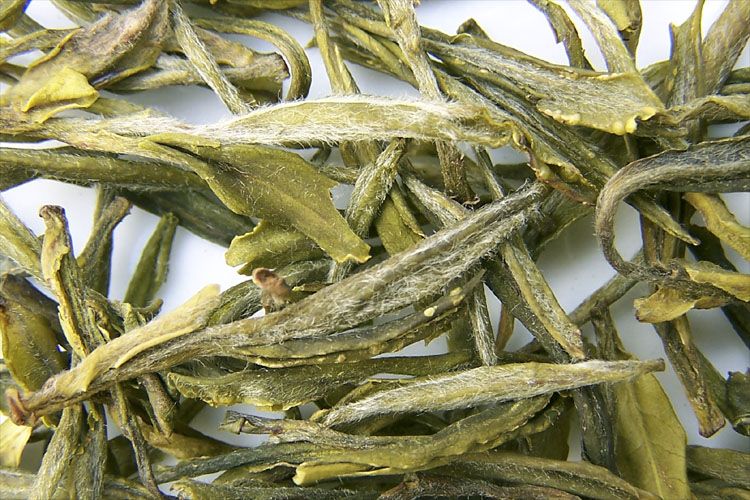 Huang Shan Mao Feng (Mao Feng of Huang Shan)
Huang Shan Mao Feng (Mao Feng of Huang Shan)
Huang Shan (Yellow Mountain) in Anhui province See Top 10 list. |
|
Jian De Bao Cha (sprout tea from Jian De) Jiande District in Zhejiang Province Originally a yellow tea, only changed to green tea in the 80s |
|
Jian Ya (sword point rung) Ningde district in Fujian province New creation. |
| Jiang Shan Lü Mu Dan (Green Peony of Jiang Shan) Jiangshan District in Zhejiang Province Not to be confused with the bound tea known in Germany "Lü Mu Dan" (tea rose). The "Jiang Shan Lü Mu Dan" gets its name from this, because the dry leaves resemble the petals of the peony. They are not bound together to form a tea rose. |
|
Jin Rong Fun Yan (Phoenix eye with golden fluff) Fuding District in Fujian Province The name of this tea is due to the shape of the tea leaves. |
|
Jin Shan Cui Ya (Jade Green Shoot of Jin Shan) Zhenjiang city in Jiangsu province The tea is named after the mountain Jinshan near Zhenjiang city. A new creation from the year 1982. |
|
Jin Tan Que She (sparrow tongue of Jin Tan) Jintan district in Jiangsu province The tea is a new creation from 1980, named after its form, the reminds of the sparrow tongue. |
|
Jing Gang Cui Lü (Jade green from Jing Gang) Jinggang mountain in Jiangxi province Jinggang Mountain is a household name to all communists in China because it is the old place of activity Des Mao Ze Dong in the 20 - 30s. The tea is a creation Early 80s. |
|
Jing Shan Cha (tea from Jing Shan) Jing Shan mountain in Yuhang district of Zhejiang province, annual production: 2500 kg. A historically very famous name, which was revived in 1980. From Jing Shan Mountain Japanese monks have taken the tea ceremony to Japan. |
|
Jing Ting Lü Xue (Green Snow of Jing Ting) Jingting mountain, Xuancheng district in Anhui province The Jingting mountain was one of the historically famous growing regions. The Green Snow was produced for the first time in the Ming Dynasty. Later it came back into Oblivion. It was revived in the 70s. |
|
Jiu Long Cha (Nine Dragon Tea) Nine Dragon Mountain, Anyuan County, Jiangxi Province The dragon spring in the growing region is famous for its good water quality for Making tea. |
|
Jiu Hua Mao Feng (Mao Feng of Jiu Hua) Jiuhua (Nine Flowers) Mountain in Anhui Province Jiuhua Mountain, one of the four most important pilgrimage sites for Chinese Buddhists, has a very long tradition of cultivation. Many famous teas have been grown in the region manufactured. Only Mao Feng has survived the time. |
|
Jiu Keng Mao Jian (Mao Jian of Jiu Keng) Chun'an district in Zhejiang province Named after the municipality of Jiukeng. The tea plant variety "Jiukeng" is one of the most important tea plant varieties in China. |
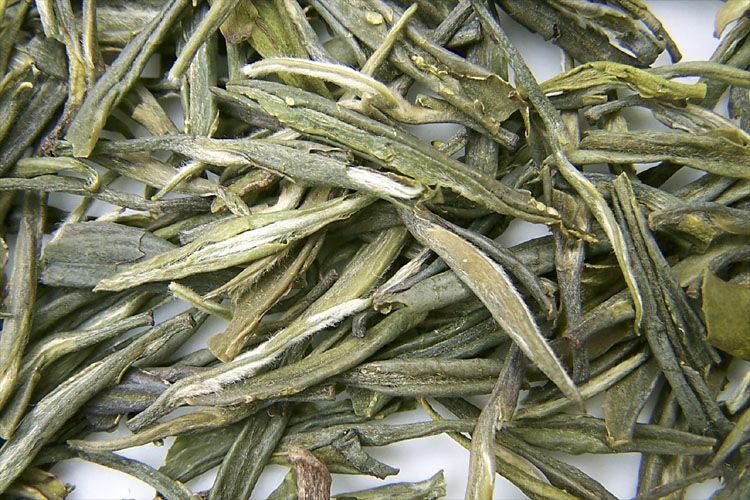 Kai Hua Long Xu / Kai Hua Long Ding / Kai Hua Long Zhen
Kai Hua Long Xu / Kai Hua Long Ding / Kai Hua Long Zhen
(Dragon beard / dragon summit / dragon needle by Kai Hua), annual production: 6000 Kg. Kaihua district in Zhejiang provinceFirst produced in the 50s, then production ceased, Revived in 1979. The highest quality level is called Dragon Needle, others Quality grades are called Dragon Beard or Dragon Peak. |
|
Lan Xi Mao Feng (Mao Feng of Lan Xi) Lanxi district in Fujian province Often processed into jasmine tea. |
|
Lao Shan Yun Feng (cloud summit of Lan Shan) City of Qingdao in Shandong province The tea is grown in the mountainous region of Lao-Berg. The Lao Mountain, located east of the former German leasehold city of Qingdao, is one of the most famous Taoist pilgrimage sites in China. Due to its immediate Close to the Chinese Baltic Sea, the region has a very mild climate, which tea cultivation is particularly favoured. 1997 refined tea plants from Zhejiang ( Long Jing 43 ) and Fujian ( Fuding Da Bai Cha ) and produced a high-quality green tea from it. From the picking to the roasting, everything is done mechanically. |
|
Lian Feng Da Hao (Big hairy tea from the Lotus summit) City of Fuzhou in Fujian province Named after the Lotus Summit near the city of Fuzhou. A new creation |
|
Lian Xin Cha (Heart of Lotus-Same) Fuding and counties; Puxia in Fujian province Named after its shape, which resembles the germ of the lotus seed. |
|
Liu An Gua Pian (melon core of Liu An) Liu'an, Jinzai, Huoshan counties in Anhui province See Top 10 list. |
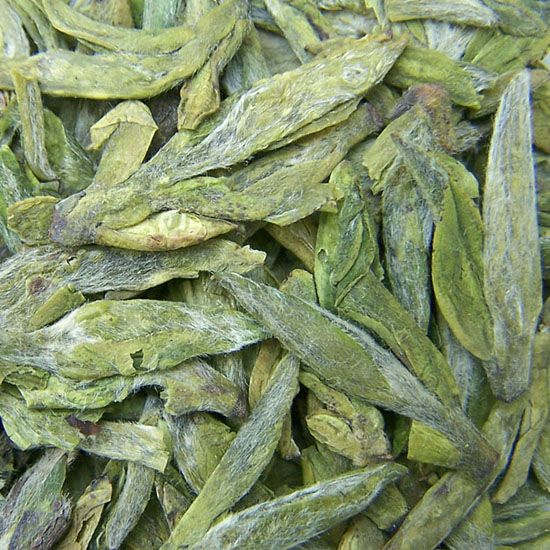 Long Jing (Lung Ching, dragon well)
Long Jing (Lung Ching, dragon well)
City of Hangzhou and surroundings in Zhejiang Province See Top 10 list. |
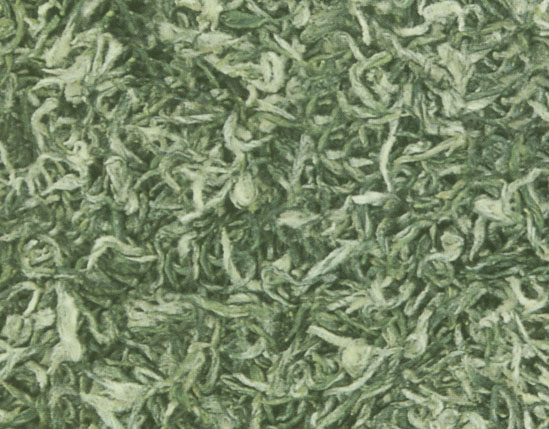 Long Hu Cui (Jade green from dragon lake)
Long Hu Cui (Jade green from dragon lake)
Pingshan district in Sichuan province A green tea made from the tea plant "Fu Ding Da Bai Cha", a tea plant for white tea, is produced. |
|
Long Wu Cha (Dragon Dance Tea) Ji'an district in Jiangxi province Named after a legend according to which a dragon conjured the tea trees here. |
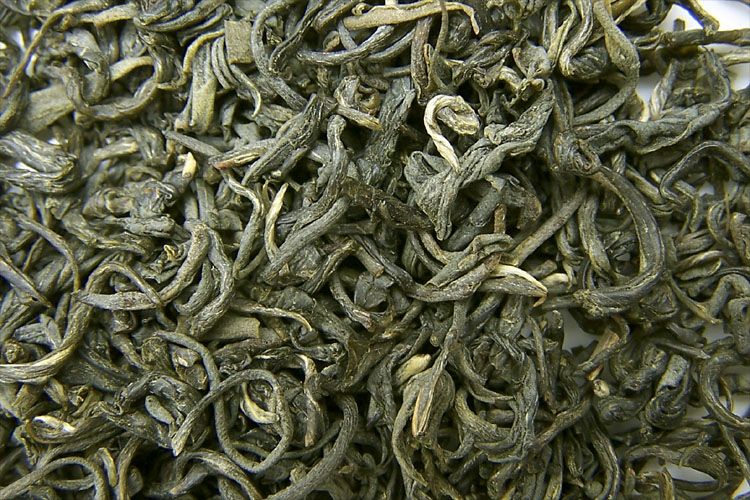 Lu Shan Yun Wu (Cloud Fog Tea from Lu Shan)
Lu Shan Yun Wu (Cloud Fog Tea from Lu Shan)
Lushan mountain in Jiangxi province Cultivated in the Lushan region, which is one of the most popular tourist regions in China.Very long cultivation tradition in the region. The tea is one of the best green teas in China. |
|
Ma Gu Cha (Ma Gu tea) Magu mountain, city/ Nancheng in Jiangxi province Named after the mountain in the growing region. |
|
Ma Gu Cha (mei lan spring) City of Fuzhou in Fujian province Created in 1991, named after the original plants "Mei Zhan" and "Qi Lan", both belong to the noble plants for Production of oolongs. |
|
Mei Long Cha (ornamental quince dragon) Jiangning District in Jiangsu Province Created in the 80s. Named after the fragrance (after decorative quince) and the shape (dragon) of tea. |
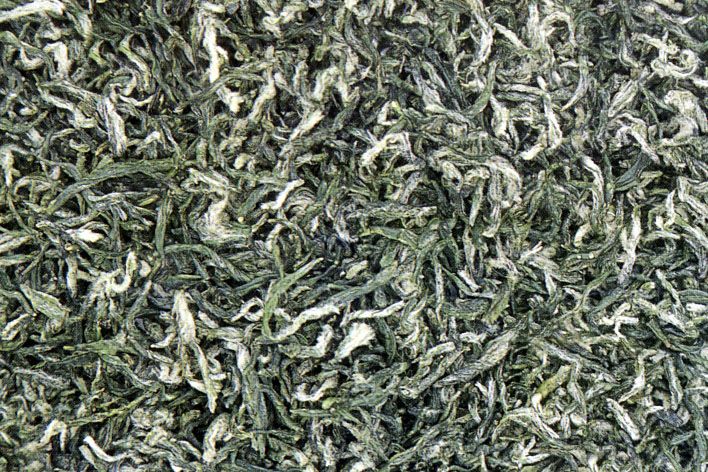 Meng Ding Cha (summit tea of the Meng Mountain)
Meng Ding Cha (summit tea of the Meng Mountain)
Meng mountain in Sichuan province The Meng Mountain in Sichuan is one of the oldest growing regions in China, and thus the world. Meng Ding Cha is the collective name for different tea varieties from the region. Well known are "Meng Ding Gan Lu" (sweet dew) and strong>Meng Ding Huang Ya" (A yellow tea). |
|
Mo Gan Yun Wu Cha / Mo Gan Huang Ya (Cloud Fog Tea from Mo Gan
/ Yellow shoots from Mo Gan) Mogan Mountain, Deqing County in Zhejiang Province |
| Nan Shan Bai Mao Cha (white-haired tea from Nan Shan) Nanshan mountain, Hengxian district in Guangxi province Named after the appearance: strong white hair |
|
Nan Yue Yun Wu (Cloud Fog Tea from Nan Yue) Hengshan mountain in Hunan province Hengshan-Berg is also known in Chinese literature as Nan Yue (The mountain in the south). |
|
Pan An Yun Feng (cloud summit of Pan An) Pan'an district in Zhejiang province Created in 1979. |
|
Pan Hao (dragon hair) Linhai district in Zhejiang province, annual production: about 1500 kg. The production area is the Yunfeng Mountain in Linhai County, a production area with long Tea tradition. The starting plant is the "Fuding Da Bai Cha", the same Plant used for the production of "Bai Hao Yin Zhen". Two green teas are produced in the same area: "Pan Hao" and "Yun Feng". "Yun Feng" has been produced since the 16th century, "Pan Hao" only since the 80s. Both teas are made with a very similar method The difference is in the drying and shaping after roasting. |
|
Ping Shui Zhu Cha (Ping Shui ball tea, Gunpowder) Ping Shui District and surroundings in Zhejiang Province mass production. Important export tea |
|
Pu Tuo Fo Cha (Buddha Tea from Pu Tuo / Buddha Tea) Putuo Mountain / Zhoushan Island Group, Zhejiang Province Putuo Mountain (on an island off the coast of Hangzhou) is one of the most famous Pilgrimage sites for Chinese Buddhists. Actually, a tea that was made by the monks was produced for own use. Since the 70s it has been produced according to the method of Pi Lo Chun. The appearance and taste are very similar to Pi Lo Chun. |
|
Pu Yang Chun Hao (spring hair of Pu Yang) Puyang district in Fujian province Created in the 80s |
|
Qi Jing Tang Lü Cha (green tea from Qi Jing Tang) Luoyuan district in Fujian province Named after the temple "Qijing Tang". |
|
Qian Dao Yu Ye (Jade leaf of Qian Dao Hu) Lake Qian Dao (Thousand Island Lake), Chun'an County, Zhejiang Province Built on the Tausend-Inseln-See - a reservoir. The many islands are mountain peaks, which protrude from the reservoir. Similar production method as the Long Jing |
|
Qian Feng Xue Lian (Snow Lotus of Qian Feng) Qianfeng Mountain, Liyang County in Jiangsu Province Created in the 80s |
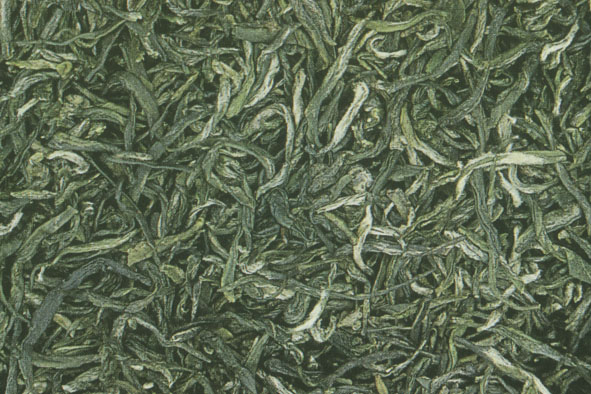 Qing Cheng Xue Ya (snow bud of Qing Cheng mountain)
Qing Cheng Xue Ya (snow bud of Qing Cheng mountain)
Qingcheng Mountain, city of Chengdu in Sichuan province Created in 1980. |
|
Quan Gang Hui Bai (White tea from Quan Gang) Shengxian district in Zhejiang province Named after the village Qiangang. |
|
Ri Zhu Xue Ya (Snow White shoot of Ri Zhu) City of Shaoxing in Zhejiang province Named after the Rizhu mountain. |
|
Rui Cao Kui (Best Lucky Weed) Langxi district, Xuanzhou in Anhui province More than 1000 years of growing tradition. |
|
Shang Rao Bai Mei (White Eyebrow of Shang Rao) City of Shangrao in Jiangxi Province Created in the 70s. The tea carries long fine white fluff, which is reminiscent of the eyebrows of old men. |
|
Shi Kou Yin Ya (silver tooth from snapdragon) Guzhang District in Hunan Province "snapdragon" is the name of a mountain in the growing region which, like a lion with his mouth open. |
|
Shi Ting Lü (Stone Pavilion Green) Nan'an district in Fujian province Named after a pavilion in the region. Very long tradition of tea cultivation. Depending on Picking season of different tea scents |
|
Shu Cheng Lan Hua (Orchid by Shu Cheng) Shucheng, Tongcheng, Lujiang, Yuexi counties in Anhui province Long cultivation tradition in the region. Orchid tea was cultivated at the latest before the Qing Dynasty already manufactured. There are two possible explanations for the name: 1. the young Shoot with a very young leaf has the shape of an orchid flower; 2. in the picking period (April) the orchids bloom, which gives the tea the scent of the orchids. |
|
Shuang Long Yin Zhen (silver needle from Shuang Long) City of Jinhua in Zhejiang province Named after the Shuanglong Cave, which is very popular with tourists |
|
Song Zhen (pine needle) Ningde district in Fujian province Created in 1995. |
|
Song Yang Yin Hou (silver monkey from Song Yang) Songyang district in Zhejiang province |
|
Sui Chang Yin Hou (silver monkey by Sui Chang) Suichang district in Zhejiang province Created in the early 80's |
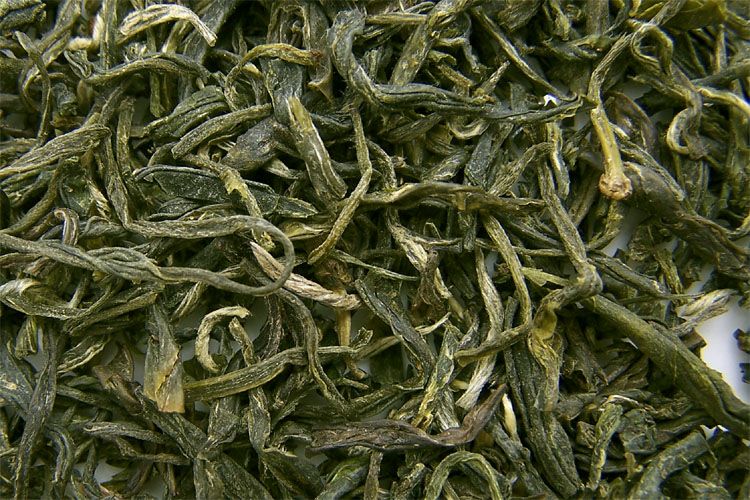 Tai Mu Cui Ya / Tai Mu Xue Ya (green shoots / snow shoots from
Tai Mu)
Tai Mu Cui Ya / Tai Mu Xue Ya (green shoots / snow shoots from
Tai Mu)
Taimu mountain in Fujian province Historical teen name. Because of the change to black tea, the production in the Qing Dynasty. Revived in the 80s. |
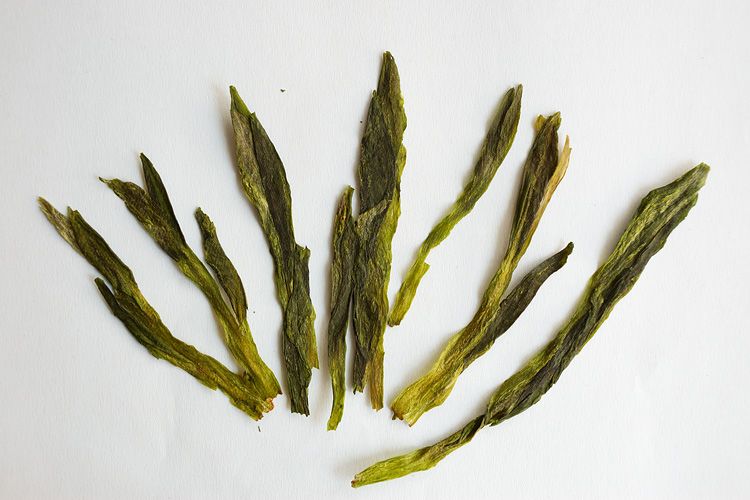 Tai Ping Hou Kui (Monkey King of Tai Ping)
Tai Ping Hou Kui (Monkey King of Tai Ping)
Taiping District in Anhui Province A very famous green tea from the neighbouring village of the Yellow Mountain. The name "Hou Kui" which translated means monkey king, has little to do with monkeys. He sets is composed of the name of a village (Houkeng) and the name of a tea farmer called Wang Kuicheng Since the tea is made from relatively large leaves, it is very difficult to remove the leaves during the production process intact. That is why Tai Ping Hou Kui is with large, intact leaves very expensive.See Top 10 list . |
|
Tian Mu Qing Ding / Tian Mu Yun Wu (Green peak of Tian Mu /
Cloud Fog Tea from Tian Mu) Tianmu mountain, Zhejiang province Named after the Tianmu (eye of the sky) mountain. |
|
Tian Zhu Jian Hao (sword hair of Tian Zhu) Tianzhu Mountain / Qianshan, Zhejiang Province Cultivation region very famous in the Tang- and Song Dynasty, later fell into oblivion. Jian Hao was newly created in 1985. |
|
Tian Zun Gong Ya (tribute tea from Tian Zun) Tonglu district in Zhejiang province Named after the Tianzun mountain |
|
Wang Hai Cha (longing for the sea) City of Ningbo in Zhejiang province New creation. |
|
Wu Niu Zao Cha (early tea from Wu Niu) Yongjia city in Zhejiang province Already in the Frebruary, the community of Wuniu is picking, therefore early tea. Produced is created using the method of Long Jing. |
|
Wu Xi Hao Cha (Hairy Tea from Wu Xi) City of Wuxi in Jiangsu province Created in the late 70s. |
|
Wu Yuan Ming Mei (Eyebrow tea from Wu Yuan) Wuyuan District in Jiangxi Province Created in 1958, named after the look reminiscent of the eyebrows of old men |
|
Wu Zhou Ju Yan (stone tea from Wu Zhou) City of Jinhua (called Wuzhou in the Song Dynasty) in Zhejiang province Historical teen name, forgotten in the Qing Dynasty, since 1979 again revitalised. |
|
Xi Shi Yin Ya (Xi Shi silver shoot) Zhuji district in Zhejiang province The tea, created in 1986, is named after Xi Shi , one of the four most beautiful Women of Chinese History, called. Xi Shi came from City of Zhuji and lived in the 5th century B.C.E. |
|
Xian Ju Bi Lü (Jade green from Xian Ju) Xianju District in Zhejiang Province Created in the early 70s. |
|
Xian Ren Zhang Cha (hand of an immortal) Danyang district in Hubei province One of the few steamed green teas in China. Named after the flat shape that reminiscent of a hand. |
| Xin Jiang Yu Rong Cha (feather tea from Xin Jiang) Xinjiang district in Jiangxi province The tea has a thick fluff which is reminiscent of bird feathers. |
|
Xin Yang Mao Jian (Mao Jian of Xin Yang) Xinyang district in Henan province Cultivation region with a very long tradition of tea cultivation. Not far from the growing region the famous " Liu An Gua Pian". |
| Xiu Ning Song Luo |
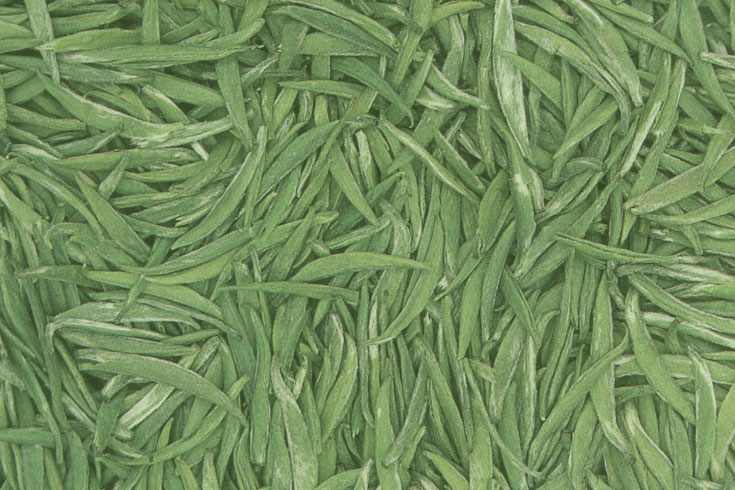 Xu Fu Long Ya (Dragon bud of Xu Fu)
Xu Fu Long Ya (Dragon bud of Xu Fu)
City of Yibing in Sichuan province |
|
Xue Feng Bai Mao Hou (White-haired monkey by Xue Feng) Xuefeng Monastery, city Fuzhou in Fujian province Named after the monastery. Created in the 90s |
| Xue Shan Mao Jian (Mao Jian of Xue Shan) Datian district in Fujian province Named after the snow-white fluff on the tea leaves. Created in 1989. |
|
Yan Dang Mao Feng (Mao Feng of Yan Dang) Yandang mountain in Zhejiang province Named after the Yandang Mountain. |
|
Yan Ding Yun Wu Cha (Cloud-Mist Tea from Yan Ding) Yanding Mountain, Fuyang County in Fujian Province |
|
Yong Xi Huo Qing (Fire green from Yongxi) Yongxi District in Anhui Province Similar production process and appearance to Gunpowder. |
|
Yu Hua Cha (rainflower tea) City of Nanjing in Jiangsu province Created in 1958, named after the village of Yu Hua-Tai. |
|
Yu Yao Pu Bu Cha (waterfall tea from Yu Yao) Pubu mountain (waterfall mountain), Yuyao district in Zhejiang province Historical teen name. Production method long lost, revived in 1979. |
|
Yun Feng (cloud top)
Linhai District in Zhejiang Province Named after the Linhai Mountain. See Pan Hao. |
|
Yun Feng Luo Hao (Hairy Snail by Yun Feng) Yunfeng / Yong'an tea plantation in Anhui province imitation of the "Pi Lo Chun" |
|
Yun Feng Mao Feng (Mao Feng by Yun Feng) Yunfeng tea plantation, Yong'an district in Zhejiang province Created in 1978. |
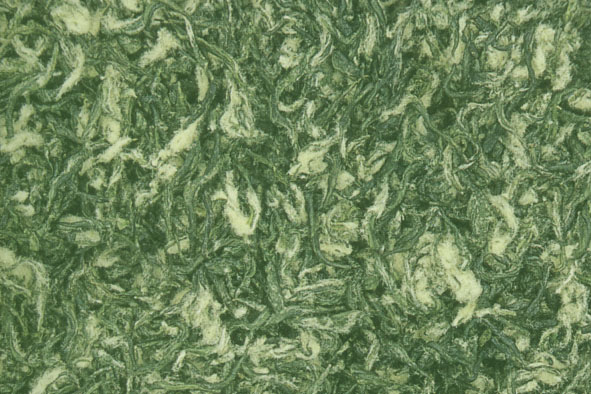 Yun Feng Mao Feng ("Zao Bai Jian"-Mao Feng)
Yun Feng Mao Feng ("Zao Bai Jian"-Mao Feng)
Gaoxian district in Sichuan province New creation. The starting plant is the "Zao Bai Jian"-plant - a small leafy Tea plant characterised by its early budding. |
